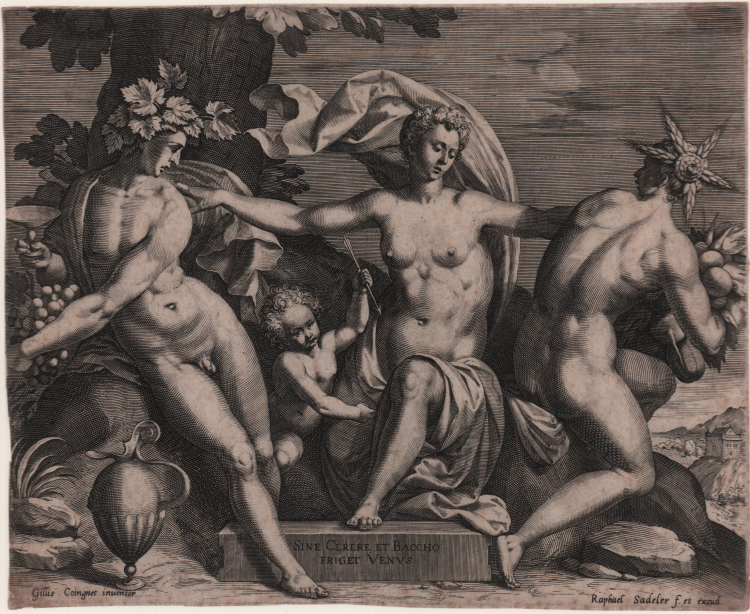



| Reference: | S32707 |
| Author | Raphael SADELER I |
| Year: | 1610 ca. |
| Measures: | 248 x 200 mm |


| Reference: | S32707 |
| Author | Raphael SADELER I |
| Year: | 1610 ca. |
| Measures: | 248 x 200 mm |
Engraving, 1610 ca. Signed in lower corners of impression: "Gillis Coingnet inuentor." and "Raphael Sadler f. et excud.". Lettered in Latin in lower part of impression, written on a stone block: "Sine Cerere et Baccho / friget Venus.".
After a lost painting by Gillis Coignet.
A good example, printed on contemporary laid paper, trimmed close to marginal line, small foxing, otherwise very good condition.
This engraving is after a lost painting by the Flemish artist Gillis Coignet (1538 – 1599).
The subject, very popular among Flemish mannerist artists, is inspired by Roman dramatist Terence, who in Eunuchus 732, writes "Sine Cerere et Libero [ancient name of Bacchus] friget Venus": Without Ceres and Bacchus, Venus Would Freeze.
Venus seated at the foot of a tree at centre, her foot resting on a stone block, Bacchus at left with wine leaves in his hair, Ceres at right and seen from behind with vegetables in her arms, Cupid holding an arrow next to Venus.
|
F.W.H. Hollstein, Dutch and Flemish Engravings, Van Gendt B.V., Blaricum, v. XXI, Amsterdam 1980, n.175 p. 248.
|
Raphael SADELER I (Anversa 1560 circa - Venezia 1628 circa)
|
The SADELER: Flemish family of artists, active throughout Europe. For three generations this family of engravers, publishers and print-sellers played a dominant role in European graphic art, producing work of great variety and high quality. They were descended from a line of steel-chisellers from Aalst . Jan de Saeyelleer (Sadeleer) had three sons, Jan Sadeler I, Aegidius Sadeler I and Raphael Sadeler I, the first generation of engravers, publishers and print-sellers. The religious and political uncertainties of the time forced them to emigrate, and they worked in Cologne, Frankfurt am Main, Munich, Venice and Prague. The next generation followed in their footsteps, of whom Aegidius Sadeler II, who worked for Rudolf II and his successors, was the most notable. Justus Sadeler, the son of Jan Sadeler I, and the three sons of Raphael Sadeler I—Jan Sadeler II, Raphael Sadeler II and Filips Sadeler—were lesser artists but continued the family tradition. The third generation was represented by Tobias Sadeler (fl Vienna, 1670–75), son of Aegidius Sadeler II; he executed engravings for topographical books. RAPHAEL SADELER I: Painter and engraver, brother of Jan Sadeler I. He moved to Cologne c. 1579 with his brother Jan I’s family; there he became his brother’s pupil and collaborated with him for the rest of his life; he also accompanied him to Munich and Italy. Like Jan I, Raphael I returned to Antwerp between 1582 and 1586. In 1582 Raphael was admitted to the Antwerp Guild of St Luke. The brothers’ collaboration included engraving and printing various series, of which the Hermits are the most important. During the Antwerp years Raphael I made engravings after such artists as Marten de Vos, Frans Pourbus, Quinten Metsys, Bartholomäus Spranger, Paul Bril and Hendrick Goltzius. From c. 1591–3 Raphael I was in Munich, where he regularly engraved after works by Joos van Winghe, Hans von Aachen and Peter Candid. Like Jan I, he also worked after Italian masters (e.g. Bassano and Carracci). It is possible that he went to Prague in 1593, the year he obtained a licence from Emperor Rudolf II.
|
|
F.W.H. Hollstein, Dutch and Flemish Engravings, Van Gendt B.V., Blaricum, v. XXI, Amsterdam 1980, n.175 p. 248.
|
Raphael SADELER I (Anversa 1560 circa - Venezia 1628 circa)
|
The SADELER: Flemish family of artists, active throughout Europe. For three generations this family of engravers, publishers and print-sellers played a dominant role in European graphic art, producing work of great variety and high quality. They were descended from a line of steel-chisellers from Aalst . Jan de Saeyelleer (Sadeleer) had three sons, Jan Sadeler I, Aegidius Sadeler I and Raphael Sadeler I, the first generation of engravers, publishers and print-sellers. The religious and political uncertainties of the time forced them to emigrate, and they worked in Cologne, Frankfurt am Main, Munich, Venice and Prague. The next generation followed in their footsteps, of whom Aegidius Sadeler II, who worked for Rudolf II and his successors, was the most notable. Justus Sadeler, the son of Jan Sadeler I, and the three sons of Raphael Sadeler I—Jan Sadeler II, Raphael Sadeler II and Filips Sadeler—were lesser artists but continued the family tradition. The third generation was represented by Tobias Sadeler (fl Vienna, 1670–75), son of Aegidius Sadeler II; he executed engravings for topographical books. RAPHAEL SADELER I: Painter and engraver, brother of Jan Sadeler I. He moved to Cologne c. 1579 with his brother Jan I’s family; there he became his brother’s pupil and collaborated with him for the rest of his life; he also accompanied him to Munich and Italy. Like Jan I, Raphael I returned to Antwerp between 1582 and 1586. In 1582 Raphael was admitted to the Antwerp Guild of St Luke. The brothers’ collaboration included engraving and printing various series, of which the Hermits are the most important. During the Antwerp years Raphael I made engravings after such artists as Marten de Vos, Frans Pourbus, Quinten Metsys, Bartholomäus Spranger, Paul Bril and Hendrick Goltzius. From c. 1591–3 Raphael I was in Munich, where he regularly engraved after works by Joos van Winghe, Hans von Aachen and Peter Candid. Like Jan I, he also worked after Italian masters (e.g. Bassano and Carracci). It is possible that he went to Prague in 1593, the year he obtained a licence from Emperor Rudolf II.
|